




Partnering to produce high quality, life-changing biotechnological treatments for patients
State-of-the-art mammalian cell culture manufacturing facilities in Europe and Asia for clinical and commercial material, ranging from 150 to 13,000 liters.
Customized solutions and efficient handling for your microbial-based products, with upstream and downstream capabilities ranging from 150 to 40,000 liters.
High-quality plasmid DNA and RNA manufacturing for various types of RNA drugs (including siRNA), mRNA vaccines and innovative gene and cell therapies, up to a scale of 3,000 liters.
Rely on a leading Cell & Gene therapy manufacturer with an excellent team and high-tech facilities.
Producing viral vectors for vaccines or cell and gene therapy in a state-of-the-art facility.

A fully integrated set of services and solutions for aseptic fill and finish of medicinal products. Available packaging systems and volumes include:
• Vials (liquid, lyophilized)
• Pre-filled syringes
• Low-level siliconized syringes
• Droptainers
• Ampules
• Tubes
Manufacturing master cell and working cell banks to enable high-quality clinical and commercial production.
We follow a comprehensive Novartis quality assurance system, with all our facilities operating in compliance with cGMP regulations.
To find out how we can help, get in touch at biotech.cooperations@novartis.com www.novartis.com/globalbiotechcooperations
In a world where biotechnology has been enabling products and processes for decades, it’s time to step out from behind the technology and claim the resulting products and their value in our everyday life. It needs higher visibility and recognition of impact, moving beyond its ‘enabling’ brand which forever makes it sound like the benefits are just around the corner, rather than the existing significant economic and industrial impact.
CLAIRE SKENTELBERY, PH.D., a biochemist by training, has worked in the development of scientific associations for 20 years. She started her career within the UK Cambridge biotech cluster and was a co-founder of the Council of European BioRegions. In Brussels from 2009, she was also Secretary General for the European Biotechnology Network, working across sectors, organisations and countries as part of the mission to facilitate partnerships. Claire became Director General of the globally-focused Nanotechnology Industries Association until November 2020 when she joined EuropaBio as Director General.

Step up ‘Biomanufacturing’. It has relevance across sectors and the language is accessible and tangible. When we speak of biomanufacturing, we speak of employment, skills, products, trade and economic growth. It perfectly fits the evolving narrative landscape for biotech. Within EuropaBio, we see biomanufacturing delivering advanced healthcare, resilient food supply chains, sustainable manufacturing across sectors…the list is a long one and it’s time to speak with a single voice. This comes at a time of critical industrial transition. Industrial processes are responding to climate change, stretched and fractured supply chains, technologies able to deliver ever more complex products and biotechnology is right in the centre.
Europe is one player amongst many in this critical industrial transition. The White House Executive Order on Advancing Biotechnology and Biomanufacturing Innovation for a Sustainable, Safe, and Secure American Bioeconomy kind of says it all really. Published in September 2022, the US aims to wire up its own complex landscape so that biomanufacturing can flourish. And the US is far from alone. China also has an innovative bioeconomy strategy and can move at a scale and speed beyond both Europe and the US.
What Europe needs, is its own joint plan for biomanufacturing. In the melee of General Pharma Legislation, Net Zero Industry Act, Novel Genomic Techniques, Taxonomy Regulation, Recovery and Resilience plans plus the 27 countries through whom these are delivered, biomanufacturing needs a focus and a strategy across sectors. We know from experience that policy can pull advanced technologies apart rather than give them the critical mass needed to bring investment for impactful outcomes. To that end, EuropaBio has launched a Bio manufacturing Platform, as an expansion of the 26-year-old association, that reflects the changing position and recognition of biotechnology through the lens of biomanufacture. It projects the activities and priorities of our members to deliver the investment and critical mass so crucial to the delivery of biomanufacturing. By the time of publication, we will have hosted our first Biomanufacturing Policy Summit, which will build visibility for biomanufacturing within European industrial and sector strategies. It marks the recognition of an important journey for Europe, one that it has already begun but needs to go faster and further, with a smooth road, clear signposts and the right destination.
Nearly thirty years ago, Bill Gates commented that “DNA is like a computer program, but far more advanced than any software ever created.”

That recognition, however, was only the first step on a long road. Reconfiguring cellular or viral DNA to create something entirely new remained stubbornly expensive for decades. Now programmable biology is maturing, and finally looks set to drive revolutions in medicine, chemistry and consumer markets.
8 EFSA: Insect protein is only the beginning
12 Statement: BioNTech leaves; what does Germany do?
14 Interview: José Maria Fernández Sousa-Faro, Chairman of the Board at PharmaMar SA
18 EU stakeholder platform set to speed up clinical trials; Petroleum giants and the greenhouse-gas lie ECONOMY 28
64 Northern Europe: Sweden, Denmark, Norway and Finland
66 Western Europe: France, Belgium, The Netherlands and the UK
68 Central Europe: Germany, Switzerland and Austria
70 Southern Europe: Italy, Spain, Slovenia and Portugal
72 Eastern Europe: Estonia, Hungary and the Czech Rebublic
74 SOS from adipose cells; Modelling fatty liver disease; Gut microbiome affects onset of multiple sclerosis
76 The price of eating ultra-processed food
PICK & MIX
81 News from Biotech Austria; the European Circular Bioeconomy Fund, Young European Biotech Network, Swiss Biotech Association, German Association of Synthetic Biology and the European Biotechnology Network
79
IMPRINT European Biotechnology (ISSN 2364-2351) is published quarterly by: BIOCOM AG, Jacobsenweg 61, D-13509 Berlin, Germany, Tel.: +49-30-264921-0, Fax: +49-30-264921-11, Email: service@ european-biotechnology.com, Internet: www.european-biotechnology.com; Publisher: Andreas Mietzsch; Editorial Team: Thomas Gabrielczyk (Editor-in-chief), Derrick Williams (Co-editor), Dr Georg Kääb, Uta Mommert, Gwendolyn Dorow, Margarita Milidakis, Maren Kühr, Arno Fricke; Advertising: Oliver Schnell, +49-30-264921-45, Christian Böhm, +49-30-264921-49, Andreas Macht, +49-30264921-54; Distribution: Lukas Bannert, +49-30-264921-72; Graphic Design: Michaela Reblin; Production: Martina Willnow; Printed at: Königsdruck, Berlin; European Biotechnology Life Sciences & Industry Magazine is only regularly available through subscription with a BIOCOM CARD. Annual subscription BIOCOM CARD Europe: €80 for private individuals (students €40) incl. VAT, €120 plus VAT for corporates. Prices includes postage & packaging. Ordered subscriptions can be cancelled within two weeks directly at BIOCOM AG. The subscription is initially valid for one calendar year and is automatically renewed every year after. The subscription can be cancelled at any time and is valid until the end of that calendar month. Failures of delivery, which BIOCOM AG is not responsible for, do not entitle the subscriber to delivery or reimbursement of pre-paid fees. Seat of court is Berlin, Germany. As regards contents: individually named articles are published within the sole responsibility of their respective authors. All material published is protected by copyright. No article or part thereof may be reproduced in any way or processed, copied, and proliferated by electronic means without the prior written consent of the publisher. Cover Photo: © Alexander Limbach - stock.adobe.com; ® BIOCOM is a registered trademark of BIOCOM AG, Berlin, Germany.
BIOSIMILARS

Europe has been very proactive in the early adoption of biosimilars, with over 70 authorised in the bloc. But distribution on the continent is uneven. Some countries use them far more than others. Market opportunities abroad are also beckoning, but only a few companies have organised strategies to expand into the Middle East or Africa. If they miss the boat, India and South Korea could slip ahead.
Pressure to focus on sustainability issues are rising for companies in every industry, and pharmaceuticals is no exception. Some firms are trying to meet requirements for environmentally-friendly packaging alternatives. They were in the limelight at this year’s Pharmapack Europe.


As recently as the 1950s, petroleum was seen as a futuristic source of progress and prosperity: Cars became a symbol of freedom, plastics an earmark of progress. Just 70 years later, fossil resources stand for environmental pollution and global warming. The EU Commission is set to ban non-reusable and non-recyclable plastic packaging by 2030, and is aiming to prohibit combustion engines by 2035. In a range of sectors, the potential consequences of the EU Plastics Strategy are already evident. At this year’s Pharmapack event in Paris, sustainability was in the front row (see p. 46). The situation is similar for CDMOs that rely on single-use bags. As Big Pharma demands ESGcompliant services, working on your green footprint has become a matter of survival for companies in the sector (see p. 41). The cosmetics, food and chemical industries have to follow suit. Many biotech firms stand to profit from the Green Deal. Driven by the belief that GDP as a parameter for prosperity can be completely decoupled from resource consumption through efficiency increases and a circular economy, the focus is now shifting to bioengineering and synbio (see p. 20), protein substitutes from the fermenter, along with biomaterials and enzymes that enable degradable plastic substitutes. But regardless of whether the green dream of growth without sacrifice comes true, a new era in biosynthesis has already begun.
Thomas Gabrielczyk Editor-in-Chief


BIOTECH Way back in 1995, Bill Gates commented that “DNA is like a computer program, but far more advanced than any software ever created.” That recognition was just the first step on a long road. For many years, reconfiguring cellular or viral DNA to create something entirely new was simply too expensive. Finally – two decades after its inception – programmable biology is set to drive revolutions in medicine, chemistry and consumption.
Although many people view genetic engineering and its advanced cousin – synthetic biology – as unnatural, a bio(tech) wave is just beginning to crest. Synbio products are rapidly permeating societies and by 2030, it’s very likely that you’ll have eaten, worn, used or been treated with at least one. Two decades after the human genome was comprehensively deciphered, DNA engineering looks set to become the dominant 21st-century technology. Products that involve reading, writing and editing DNA to redesign existing systems found in nature are already well advanced, or about to enter the market. They include synthetically produced viruses (among them polio, flu or SARSCoV-2), AI sequence-optimised mRNA vaccines, genetically engineered CAR-T cells, living therapeutics released to restore the gut microbiome after disease biomarkers have been detected, gene-scissored crops, programmed production strains for chemical manufacture of chemicals, microplastics-free fibres and biofuels. The field is already changing medicine, agriculture and – to some extent – petroleumbased chemistry.
“Since the publication of the first papers in Nature in 2000, synthetic biology has diversified so much,” says Martin Fussenegger from the ETH Zurich/University of Basel. Five years ago, he healed

mice of both gout and diabetes by means of encapsulated gene circuits. By 2021, scientists had created the first self-replicating xenobot – a programmable syn-
! We have some catching up to do, especially in the transfer from academic research – where Europe plays a serious role in many areas –to commercial application. Incentives are needed for researchers, venture capitalists and critical infrastructure managers to exchange more. Policymakers also seem to be still divided, despite success stories like Impossible Foods or BioNTech.
thetic organism derived from frog cells and designed by artificial intelligence (doi: 10.1073/pnas.2112672118). According to Fussenegger, “synbio has evolved to become the engineering science of biology, similar to chemical engineering for chemistry.” Depending on how and where they are applied, human-designed DNA technologies have the potential to stop the destruction of the environment and the climate catastrophe through new production methods, to offer healthy alternatives to factory farming, and to restore natural cycles that have been thrown out of balance by toxic fossil chemistry and the endless quest for profit. For instance, continuing to produce polyethylene, a material that persists for hundreds of years in the environment before breaking down into toxic microplastics, is not a good idea, even if it is made from waste or industrial emissions. It’s now time to move away from the old ‘jobs and growth’ mentality of the petroleum age, because permanent growth is neither natural nor sustainable. Economists like Maja Goepel, who has advised the German government, believe that the current economic paradigm must change in ways that allow companies to make profits without destroying frameworks.
›› Read the full story in the printed issue

BIOSIMILARS The region regulated by the European Medicines Agency (EMA) has been the most proactive globally in the early adoption of biosimilars. By February 2023, it had approved around 75 products containing them. The distribution of such compounds within Europe, however, has been uneven, with some countries offering more market opportunities than others. Beyond Europe, few producers have a strategy for the Middle East and/or Africa, and India and South Korea could soon jump in to fill the gap.
The European Union core (EU5) and the Nordic countries in particular have seen very high market penetration of biosimilars – medicines that mimic specific blockbuster biologics. In general, biosimilars tend to follow the global distribution path taken by their originator biologics, with a key difference: in the area, the European healthcare market is ahead of the US. The popularity of a biosimilars business model has grown steadily and constantly. In 2021, for example, the global biologics market was estimated to be worth almost US$366bn, with biosimilars making up only around 4% of the total (US$16bn). However, according to a report by IQVIA, they saw particularly strong growth of about 80% CAGR in the period 2015-2019. That translates into a near doubling in value annually.
The general trend towards high market penetration for biosimilars is expected to continue, as several blockbuster reference biologics are soon going off patent. Two of the latest prominent additions to the list are Avastin/bevacizumab and Lucentis/ranibizumab. It’s interesting to note though that across the major world regions, biosimilar penetration varies widely, and appears to run somewhat counter to conventional economic rules.
One surprising example of this is that the US appears to be lagging behind Europe in the use of biosimilars. Since 2007, only 30 biosimilars have launched in the United States, although at least 10 more are in the approval process and are expected to hit the market by the end of 2023. In addition to the 12 specific active ingredients already being copied (some active ingredients have several biosimilar substitutes), a total of 20 different molecules are then expected to be either approved or in advanced stages of clinical development in the US. In terms of numbers of active ingredients with biosimilar imitation products, the US and Europe are therefore comparable. But the variety of products issued by different manufacturers is much greater in Europe.
The experience has shown, however, that market penetration of biosimilars in the US can happen rapidly. An American study of Community Oncology Alliance practices found a dramatic increase in biosimilar uptake for trastuzumab (Herceptin) – which first hit the market in July 2019 – and bevacizumab (Avastin). In the fourth quarter of that year, participating practices reported 8,000 bevacizumab biosimilar administrations compared to 21,000 for the reference product. In other words, around 28% of all administrations were for biosimilar bevacizumab. By the fourth quarter of 2020, just
15 months later, bevacizumab biosimilars had already reached a share of nearly 60% of all administrations. In addition, participating practices reported a 27% increase in the number of patients treated after the biosimilars entered the market, almost certainly because the therapy had grown more affordable.
Estimates from the Association for Accessible Medicines, the trade association for generic and biosimilar manufacturers, say that savings from biosimilars in the United States will total US$85-US$133bn by 2025. And as Joe Biden’s Inflation Reduction Act kicks in, the landscape should grow even more dynamic in the future.
But even when the EMA gives central approval for biosimilars, Europe is not a uniform market. This is because the agency says nothing about availability, nor how a newly approved biosimilar will rank in comparison to the original preparation in the 27 different reimbursement systems of the bloc’s respective healthcare systems.
The latest (2021) biosimilar report from the European industry association Medicines for Europe examines the availabil-
›› Read the full story in the printed issue
DRUG DISCOVERY Seasonal flu is a common infectious disease of the respiratory tract caused by influenza virus. Vaccination is the most effective way to prevent flu infection. Each year, several different flu strains are selected as vaccine candidates based on surveillance data of the recent isolates and the performance of the vaccines from the previous season.
On February 24 th , 2023, the World Health Organization (WHO) announced the recommendations for influenza vaccine composition for the 2023/2024 northern hemisphere influenza season. To support vaccine research, Sino Biological has released the recombinant antigens for 2023/2024 influenza vaccine strains.

With the world’s largest viral antigen collection, ProVir ®, Sino Biological provides a range of recombinant influenza antigen products, including hemagglutinin (HA), neuraminidase (NA), and nucleoprotein (NP) proteins from all WHO-recommended vaccine strains in recent years. A large collection of monoclonal antibodies against the flu antigens are also available to support the development of relevant assays and diagnostic kits.
Learn more about our reagents

For biotechnologists, Europe is a collaborative research area. For the biotech industry it is a huge common market with almost 500 million potential customers. The 13th edition of the European Biotechnology Guide presents an attractive cross-section of companies and institutions from 16 nations.

188 pages, available at local bookstores or online.
ISBN 978-3-928383-87-5
19.80 Euro

END-TO-END CDMO
Live and inactivated bacterial and viral vaccines up to BSL-2
Aseptic processing systems
_ Aseptic filling into vials
Lyophilization for clinical trial material and large-scale production
Process development and optimization
Quality control testing: microbiological, sterile/nonsterile, chemical-physical, and biological
Storage: (2º - 8ºC), (-20ºC), (-30ºC), (-80ºC)
WE ARE A FULL-SERVICE PROVIDER WITH 30 YEARS OF EXPERIENCE IN VACCINE DEVELOPMENT AND MANUFACTURING.
LARGE-SCALE BIOTECH MANUFACTURING

CZ VACCINES has several GMP certified production plants in Spain and Portugal.


HUMAN AREA

O Porriño (SPAIN)
Paredes de Coura (PORTUGAL)
VETERINARY AREA
León (SPAIN)
cGMP PRODUCTION CAPABILITIES
cGMP preparation and control of Master and Working Seed Banks of cells, virus and bacteria
Roller bottles, cell factory and wave bioreactor
Single-use bioreactors: up to 2 x 2,000L
Stainless steel bioreactors: up to 2 x 2,000L
Single-use blending mixers: 2 × 3,000L
Stainless steel vessels: 4 × 6,000L
State-of the art purification processes: Chromatography (ÄKTA ready), centrifugation, ultrafiltration, diafiltration and tangential flow filtration
cGMP FILL & FINISH CAPABILITIES
Liquid and lyophilized products up to BSL-2
4 filling machines: 6,000 vials/hour, 2 x 12,000 vials/hour and 24,000 vials/hour
2 freeze dryers: up to 24,000 vials per run, and up to 180,000 vials per run with an automatic loading & unloading system

Component size: 2R-10R-20R
Manual & automatic visual inspection Labeling & packaging
We cover the entire value chain, from contract development through clinical phases I to III, to commercial production of vaccines and other biological products.